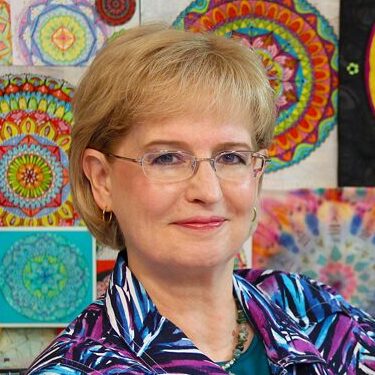In this class you will learn how to transform hard-to-handle silky fabrics with a felting machine. When you start with the right foundation fabric, a good felting machine and lots of colorful silky fabrics, you’re on your way to creating something beautiful and fun, too. You won’t believe what you can do with this machine!
Members, simply click the purple button below to watch the video class.
Become a member today, just click the green button below for access to ALL the video classes. It's easy!
As a little girl, I remember admiring colorful pieces of felt stitched into ornaments, pillows, Christmas stockings and table runners lovingly created by my adopted grandmother. I was fascinated by the texture and threads and touch of this unique textile. I never dreamed that one day I would learn how to create such beautiful fabric myself!
Felt is created by tangling and matting fibers. The process is easily accomplished with animal fibers like wool because of its scale structure. When scales collapse, felting occurs. The more that fibers are tangled together, the thicker and denser the fabric becomes.
The two most common methods for creating felt involve water, soap and agitation or by mechanical means. Both types of felting methods use compression to successfully tangle fibers into a strong cohesive fabric. Wet felting is possible only with animal hair like sheep’s wool, mohair from goats and angora from rabbits. Synthetics and plant fibers will not wet felt. They may be captured within some of the layers of a wet-felted fabric, but they themselves cannot actually be wet-felted.
Needle felting, on the other hand, requires no water or soap, but it does necessitate some type of mechanical means to cause the tangling process to occur. Felting needles may be used singly, in a multi-needle handheld tool or with various industrial machines. Portable felting machines are now easily available, thanks to home sewing machine manufacturers.
So, how does the needle felting process happen? Special needles, commonly called barbed needles, are housed within a special holder that attaches to a needle felting machine. In actuality, the needles are notched rather than barbed. The notches face in a downward direction toward the tip of the needle. When in use, they push the fiber to cause the felting process. When the needles pull up through the developing fabric, the smoothness of the needle will not disturb the felting. After fibers are successfully tangled and compressed, the resulting fabric is surprisingly strong.
Needle felting can be accomplished with just a single needle. Often this is used to create hand sculpted three-dimensional pieces or to root wool hair into a doll's head.
Hand held tools, which hold several needles at one time, have become popular because it cuts the time needed to create small two-dimensional sheets of felt or to use for hand basting fibers prior to machine needle felting. Household felting machines, however, make the needle felting process thousands of times faster and that means you can create fabulous fabrics quickly and easily.
Did you know that it’s also possible to machine needle felt synthetic and silky fabrics? Indeed it is! That’s what this class is all about. Download your class notes, watch the video class and get ready to create something so unique that people will always ask, “How did you do that?!”
Remember to Get Creative today! It’s Easy!
Barb

